Areuse峡谷的Saut du Brot石桥,瑞士纳沙泰尔 Saut du Brot stone bridge in the Areuse Gorge, Neuchâtel, Switzerland (© Andreas Gerth/eStock Photo)
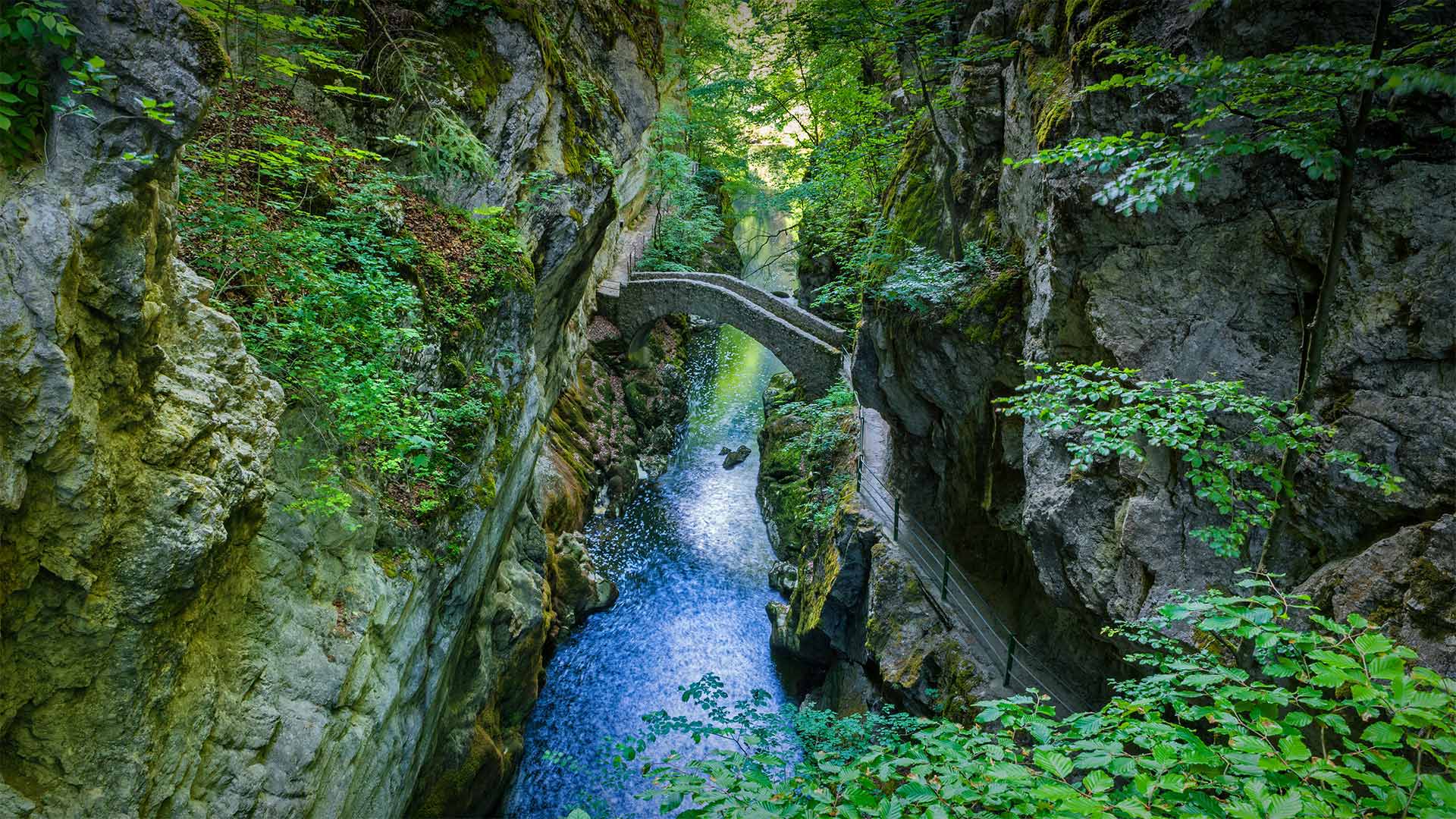
Areuse峡谷的Saut du Brot石桥,瑞士纳沙泰尔 Saut du Brot stone bridge in the Areuse Gorge, Neuchâtel, Switzerland (© Andreas Gerth/eStock Photo)
Once upon a time there was a bridge…
Although this stone bridge, known as Saut de Brot, looks right out of a fairy tale, it serves a very practical purpose. It connects walking trails on each side of the Areuse Gorge, offering safe passage to hikers exploring the lush Brot-Dessous area in eastern Switzerland, a predominantly French-speaking region of this multilingual country. It's not known when the bridge was built exactly, though it's thought to be a recent construction. But if that's true, how do we not know who built it? All this mystery leads us to suspect it's the work of helpful gnomes and fairies living deep in the Swiss woods.
从前有一座桥…
尽管这座被称为索特德布罗特(Saut de Brot)的石桥看起来就像童话故事,但它有着非常实际的用途。它连接阿瑞斯峡谷两侧的步行道,为徒步旅行者探索瑞士东部郁郁葱葱的布罗特-德索斯地区提供安全通道,这是一个多语种国家的主要法语地区。虽然这座桥被认为是最近才建造的,但不知道它到底是什么时候建造的。但如果这是真的,我们怎么不知道是谁建的呢?所有这些谜团让我们怀疑这是生活在瑞士森林深处的有益的侏儒和仙女的作品。
清明( © yangphoto )
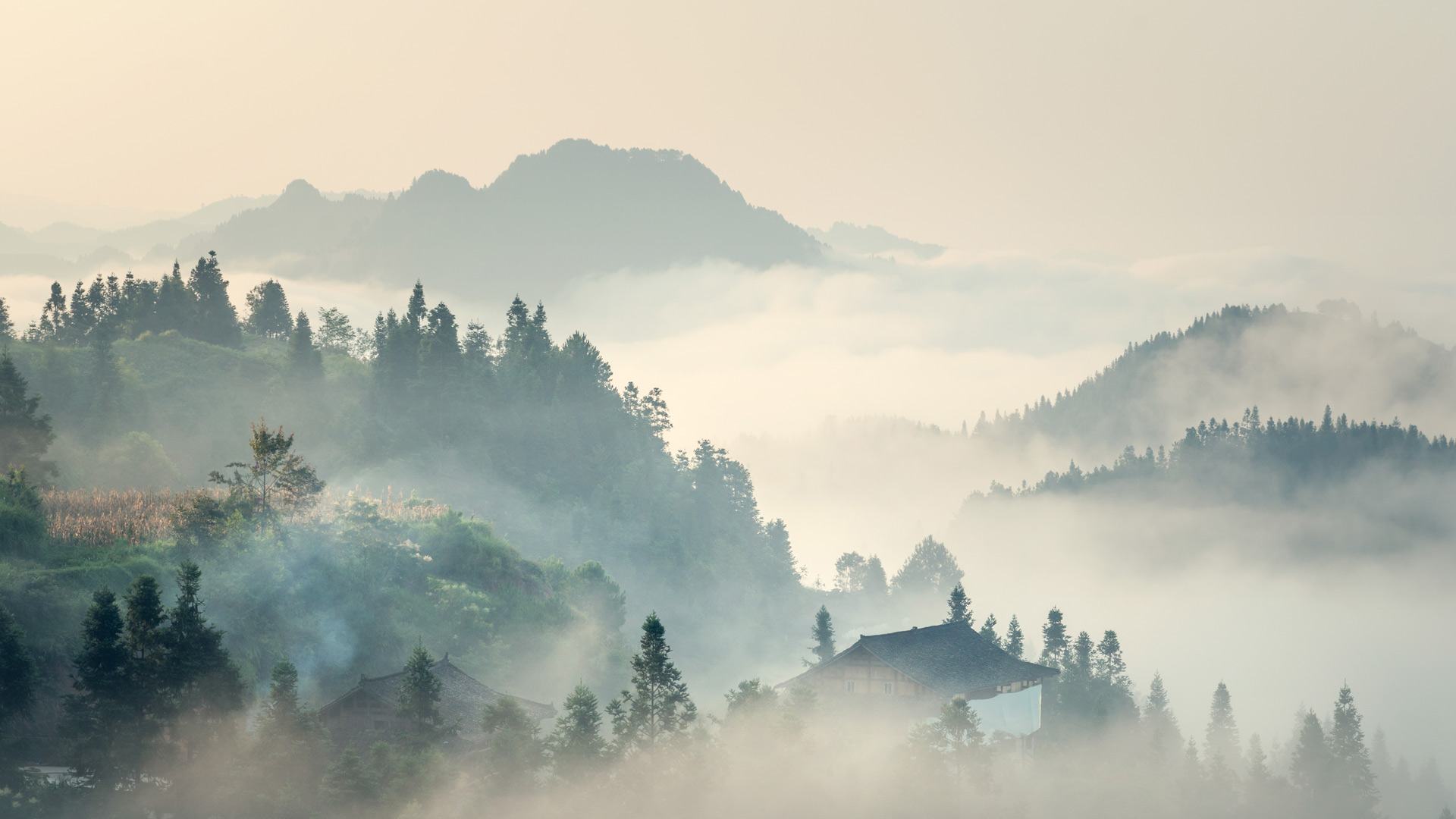
【今日清明】( © yangphoto )
阿尼瓦角的灯塔,俄罗斯萨哈林岛 Lighthouse at Cape Aniva, Sakhalin Island, Russia (© Amazing Aerial Agency/Offset by Shutterstock)
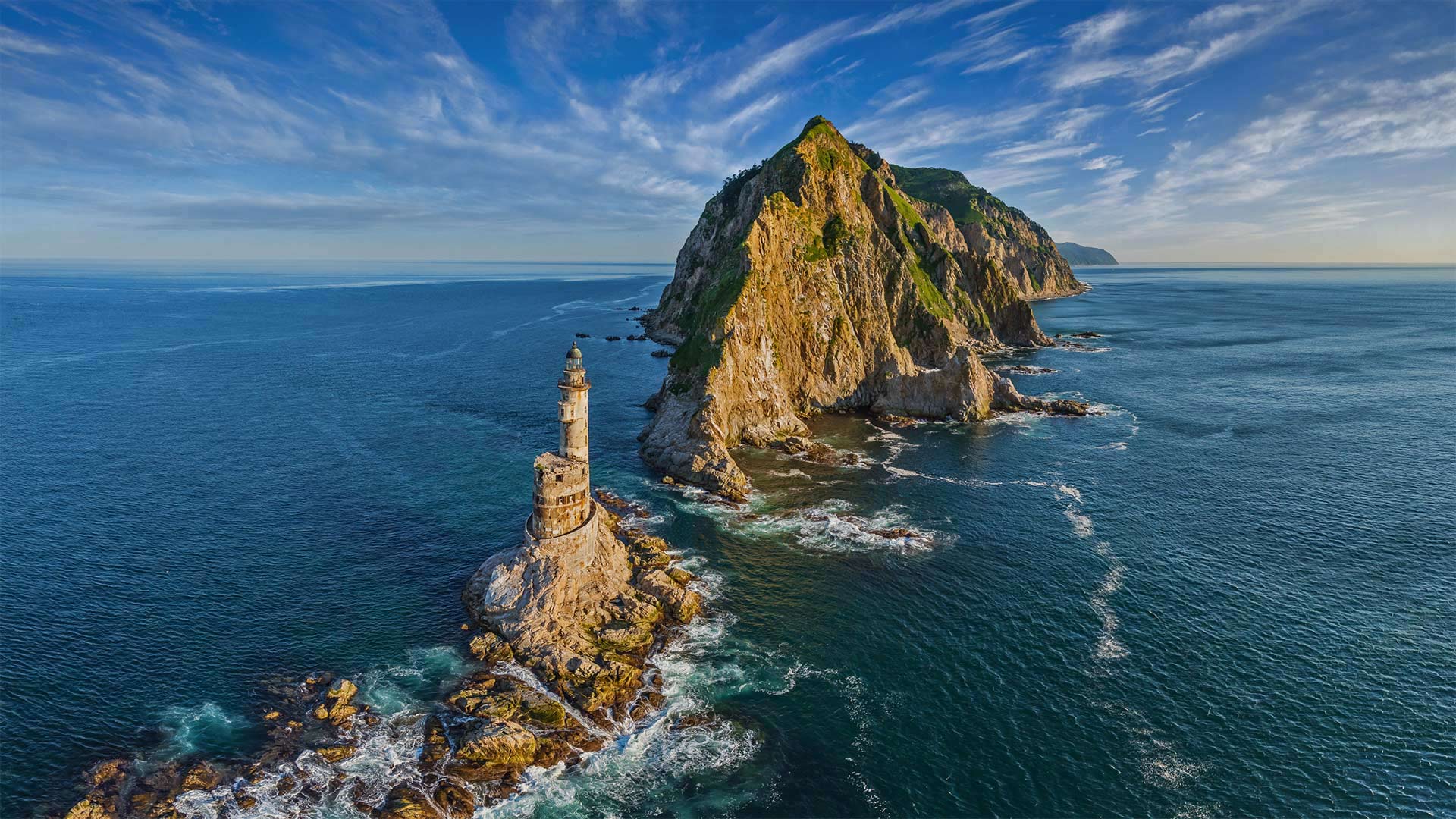
阿尼瓦角的灯塔,俄罗斯萨哈林岛 Lighthouse at Cape Aniva, Sakhalin Island, Russia (© Amazing Aerial Agency/Offset by Shutterstock)
A light at the edge of the world
Seemingly against all odds, the Aniva Lighthouse stands atop this rocky outcrop where it once lit the way for vessels navigating the fierce currents, hidden rocks, and frequent fogs of Cape Aniva on the island of Sakhalin. Russia's largest island, Sakhalin lies off the mainland's Far East coast, due north of the Japanese island of Hokkaido. The island was hotly contested by both Russia and Japan in the 19th and early 20th centuries. In the late 1930s, when the Aniva Lighthouse was built, Russia controlled the northern half of Sakhalin while...
世界边缘的一盏灯
阿尼瓦灯塔似乎与所有的可能性背道而驰,它矗立在这块岩石露头之上,曾经为船只在萨哈林岛上的阿尼瓦角激流、暗礁和频繁的浓雾中航行照亮了道路。萨哈林岛是俄罗斯最大的岛屿,位于大陆远东海岸,日本北海道岛正北。在19世纪和20世纪初,这个岛屿受到俄罗斯和日本的激烈争夺。上世纪30年代末,阿尼瓦灯塔建成后,俄罗斯控制了萨哈林岛的北半部,而。。。
伦索伊斯马拉年塞斯国家公园,巴西巴雷里尼亚斯市 Lençóis Maranhenses National Park in Barreirinhas, Brazil (© WIN-Initiative/Getty Images)
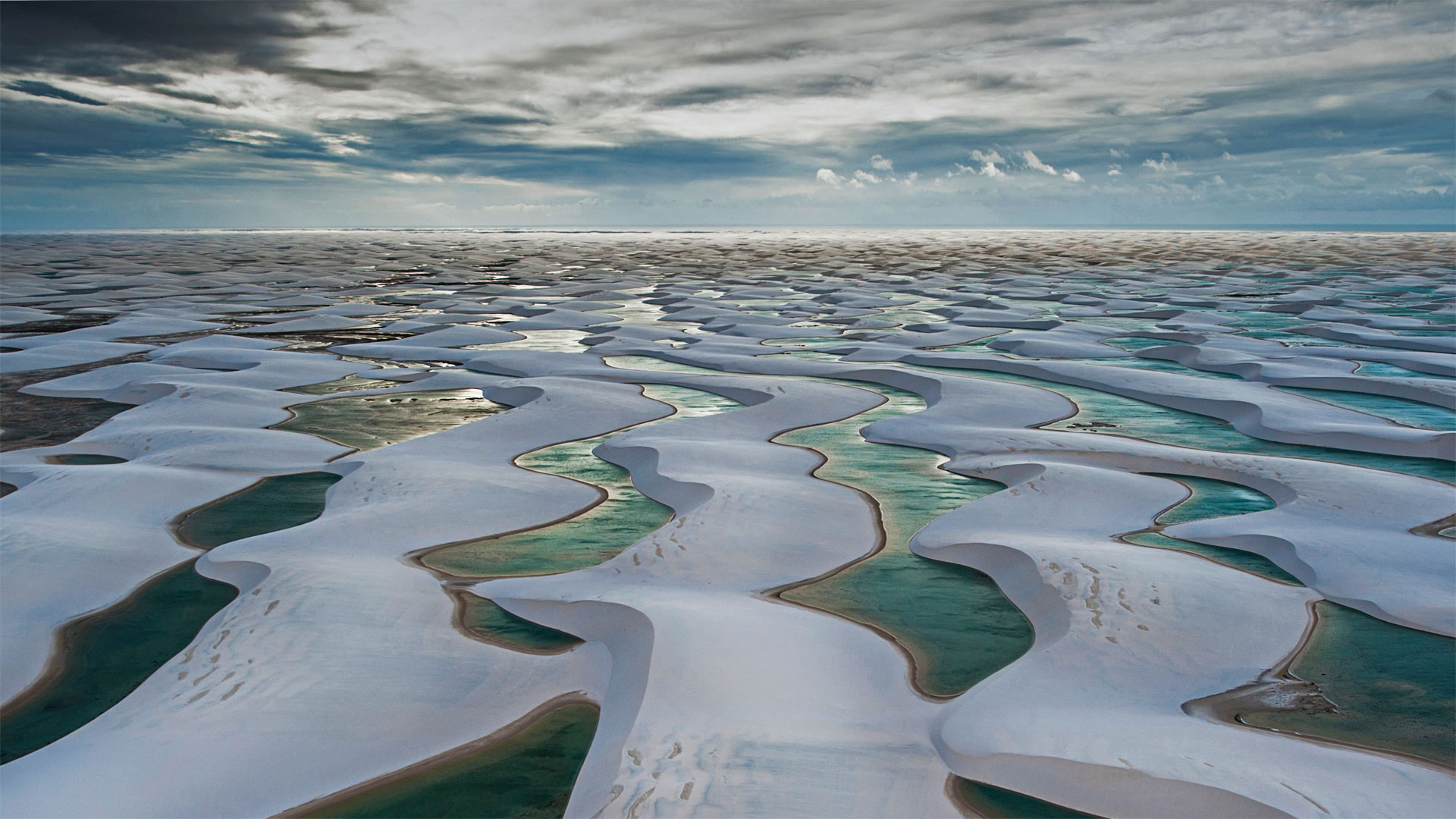
伦索伊斯马拉年塞斯国家公园,巴西巴雷里尼亚斯市 Lençóis Maranhenses National Park in Barreirinhas, Brazil (© WIN-Initiative/Getty Images)
White dunes, blue lagoons
From the air, the mesmerizing tapestry of sandy dunes and lagoons you see here gives Lençóis Maranhenses National Park an otherworldly, desert-like appearance. Located in the sparsely populated Northeast corner of Brazil, this park gets far too much annual rainfall—nearly 50 inches—to be considered a desert. In fact, heavy rain is part of what makes this place unique: Nearly 70% of its annual rainfall comes between January and May, filling the park's nearly 40,000 lagoons to the brim with fresh rainwater. Why doesn't the water sink into the sand? A layer of impermeable bedrock beneath the dunes prevents that from happening.
Despite its remote location, the park, established in 1981, has become a popular destination for ecotourists. They come partly to see the many kinds of animals and plants that manage to thrive here, including several endangered species. One of the park's most famous inhabitants is the predatory Atlantic wolffish, which lies dormant during the dry season by burying itself into the layers of wet mud in the lagoons, only to reemerge to snack on unsuspecting prey as the pools refill with the rains.
白色沙丘,蓝色泻湖
从空中看,这里迷人的沙丘和泻湖挂毯给了伦索斯马兰森斯国家公园一个超凡脱俗的沙漠般的外观。这个公园位于巴西人口稀少的东北角,年降雨量高达近50英寸,不算沙漠。事实上,暴雨是这个地方独特之处的一部分:每年近70%的降雨量来自1月至5月,公园近4万个泻湖被新鲜雨水填满。为什么水不沉进沙子里?沙丘下面的一层不透水的基岩阻止了这种情况的发生。
尽管地理位置偏远,但这座建于1981年的公园已成为生态旅游者的热门目的地。他们来这里的部分原因是看到许多种类的动植物在这里繁衍生息,包括一些濒临灭绝的物种。该公园最著名的居民之一是捕食性的大西洋狼鱼,它在旱季蛰伏在泻湖的湿泥层中,结果又重新出现,在雨水不断涌入的池塘中捕食毫无防备的猎物。
拉贾安帕特群岛中的瓦亚格岛,印度尼西亚 Wayag Island at Raja Ampat, Indonesia (© Amazing Aerial Agency/Offset by Shutterstock)
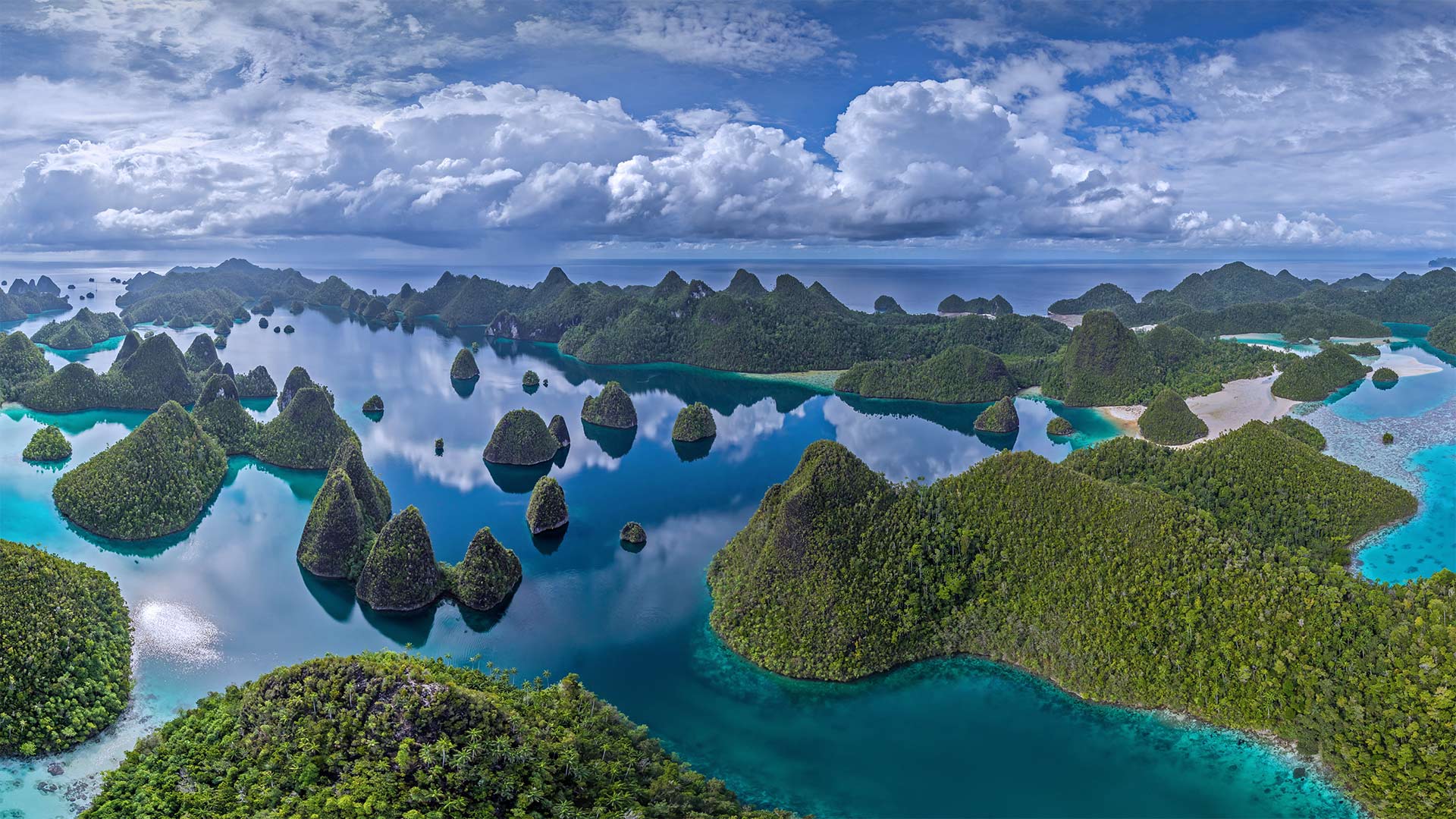
拉贾安帕特群岛中的瓦亚格岛,印度尼西亚 Wayag Island at Raja Ampat, Indonesia (© Amazing Aerial Agency/Offset by Shutterstock)
Paradise, found
If your dream is to experience a tropical paradise that's still largely untouched by people, you could do worse than a trip to Wayag Island, seen here. It's part of the Raja Ampat district in the province of West Papua, Indonesia. Most of the roughly 50,000 inhabitants of this district live on or around its four main islands, Batanta, Misool, Salawati and Waigeo. The remainder of Raja Ampat is made up of roughly 1,500 smaller islands, cays, and shoals–astonishingly, hundreds of these tiny islands have yet to be explored by humans.
Divers and snorkelers, especially, treasure Raja Ampat and its vast and diverse reef system, which is considered one of the most biodiverse places in the world. Located roughly seven miles above the equator, Raja Ampat covers nearly 10 million acres of land and sea, and is home to 540 types of corals, more than 1,000 types of coral reef fish, 700 types of mollusks, and a variety of warm-blooded marine animals like the dugong. The ecosystem, which is part of a larger tropical ocean area called the Coral Triangle, is so diverse it's sometimes referred to as the 'the Amazon of the seas.'
天堂,找到了
如果你的梦想是去体验一个热带天堂,那里基本上还没有被人接触过,你可能会比去瓦亚格岛旅行更糟糕,如图所示。它是印度尼西亚西巴布亚省拉贾安帕特区的一部分。这个地区大约5万居民中的大多数居住在巴坦塔岛、米苏尔岛、萨拉瓦蒂岛和怀吉岛四个主要岛屿上或附近。拉贾安帕特的其余部分由大约1500个较小的岛屿、珊瑚礁和浅滩组成——令人惊讶的是,数百个这些小岛还没有被人类探索过。
潜水员和潜水者,尤其是珍宝拉贾安帕特及其广阔多样的珊瑚礁系统,被认为是世界上生物多样性最丰富的地方之一。Raja Ampat位于赤道上方约7英里处,占地近1000万英亩,是540种珊瑚、1000多种珊瑚礁鱼类、700多种软体动物以及儒艮等多种温血海洋动物的家园。这个生态系统是一个被称为珊瑚三角洲的更大的热带海洋区域的一部分,其多样性使它有时被称为“海洋亚马逊”
黑沙滩上Reynisdrangar的玄武岩,冰岛 The basalt rock formations of Reynisdrangar on Reynisfjara Beach, Iceland (© Cavan Images/Getty Images)
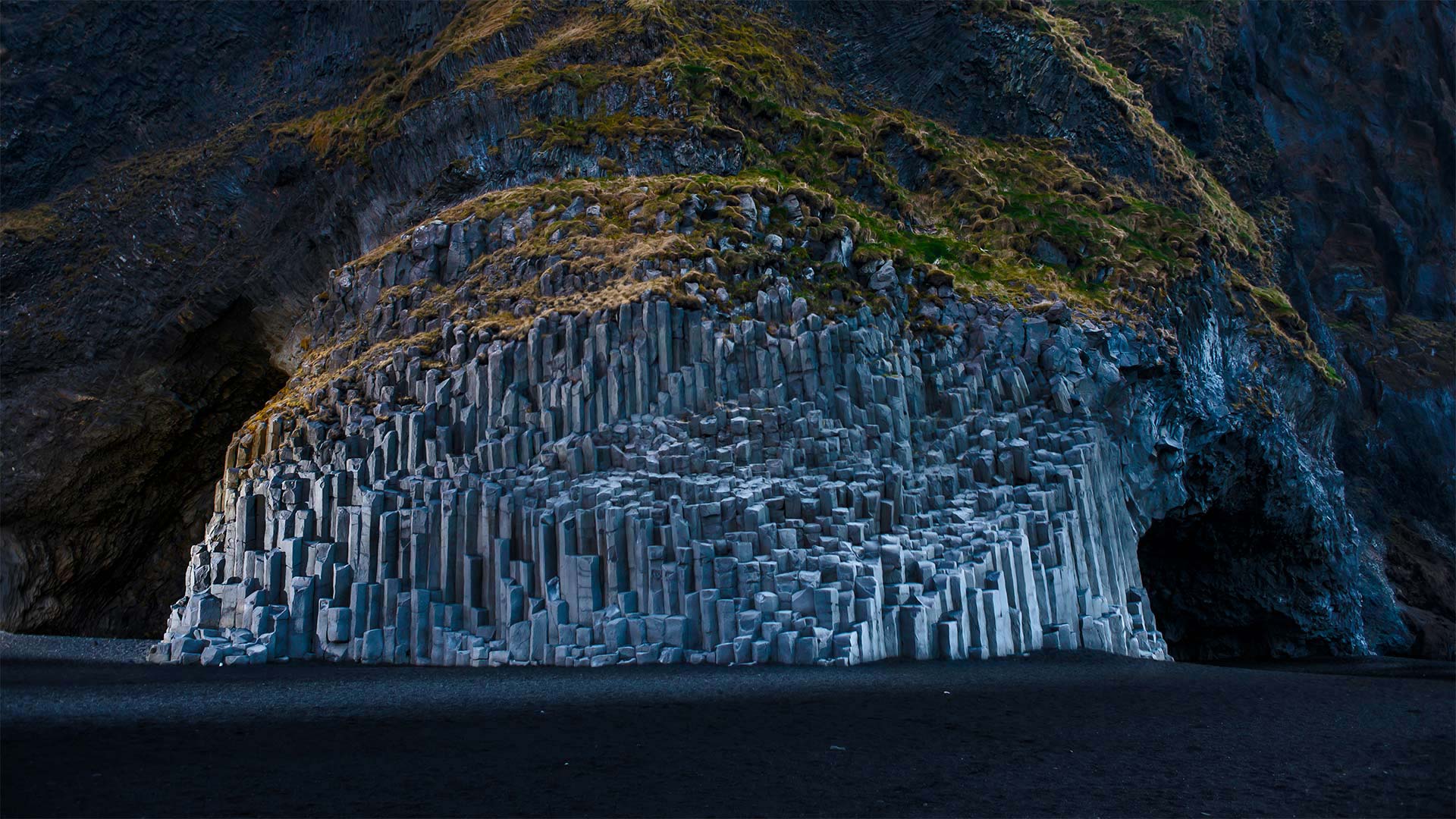
黑沙滩上Reynisdrangar的玄武岩,冰岛 The basalt rock formations of Reynisdrangar on Reynisfjara Beach, Iceland (© Cavan Images/Getty Images)
Rising up from the black sand like rock gods
Any visitor to Iceland knows that driving the Ring Road rewards one with incredible changing landscapes. Today, we're taking a quick detour to visit this chiseled stretch of Iceland's southern coast, where black sand beaches meet spiky basalt sea stacks. This is Reynisfjara Beach, widely considered the most beautiful example of Iceland's black sand beaches. The sea stacks fronting the beach are known as Reynisdrangar and were formed when a volcano erupted, spewing flowing lava that cooled into these formations. Ask the locals how they formed, however, and you may get a different story, one involving trolls and a battle with a three-masted ship.
像岩石神一样从黑沙中升起
任何一个到冰岛的游客都知道,驾驶环城公路的人都会得到令人难以置信的景观变化的回报。今天,我们要绕道去参观冰岛南部海岸的这片轮廓分明的地带,那里的黑色沙滩与尖尖的玄武岩海交汇。这就是雷尼斯菲亚拉海滩,被广泛认为是冰岛黑沙滩最美丽的例子。海滩前面的海堆被称为雷诺斯德兰格,是火山喷发时形成的,喷发出的熔岩冷却成这些地层。然而,问问当地人他们是如何形成的,你可能会得到一个不同的故事,一个涉及巨魔和一艘三桅船的战斗。
斯诺登山与兰贝里斯山口,英国史诺多尼亚国家公园 Mount Snowdon and the Llanberis Pass in Snowdonia National Park, North Wales, United Kingdom (© Alan Novelli/Alamy)
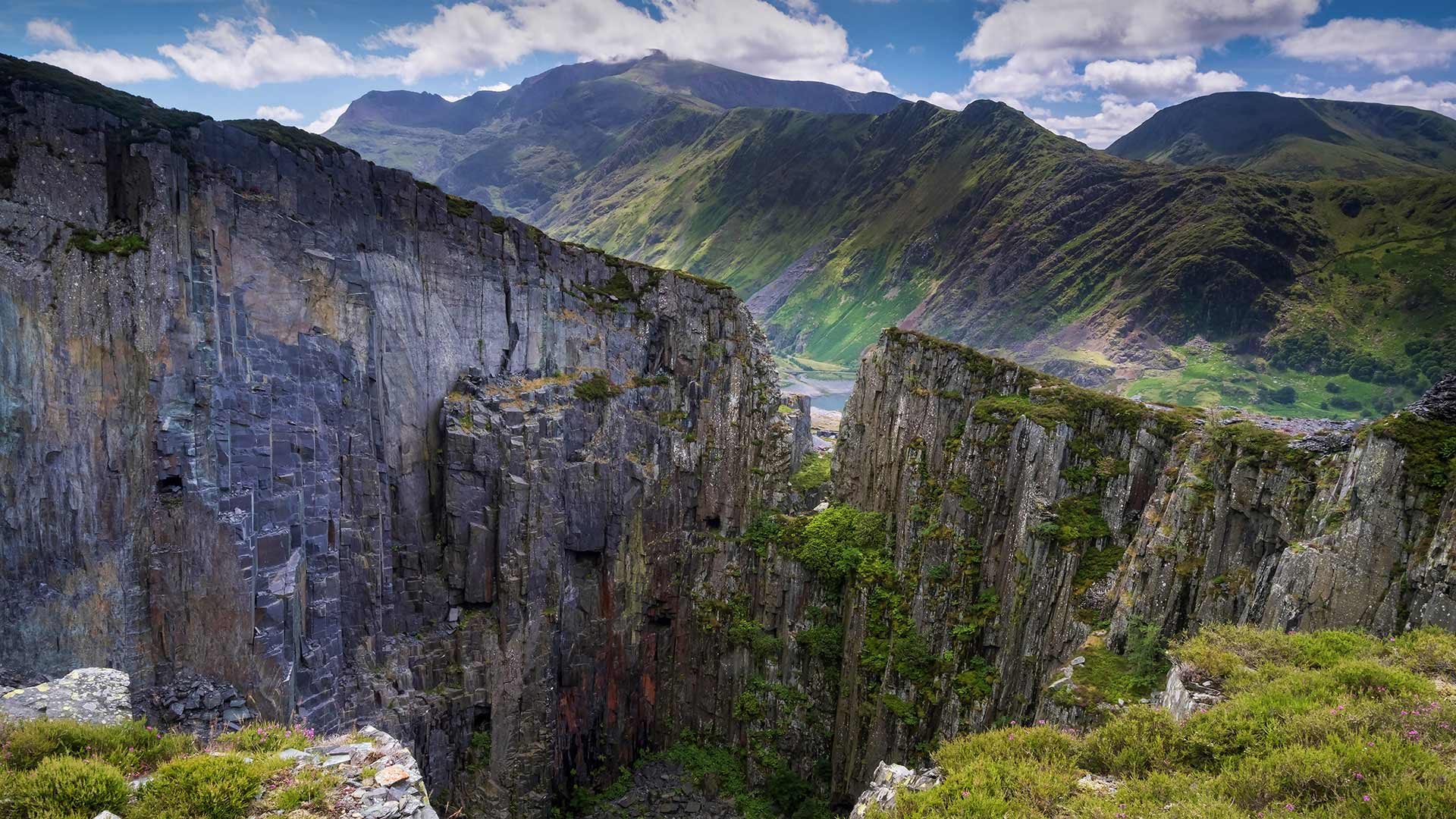
斯诺登山与兰贝里斯山口,英国史诺多尼亚国家公园 Mount Snowdon and the Llanberis Pass in Snowdonia National Park, North Wales, United Kingdom (© Alan Novelli/Alamy)
A chiselled landscape
This dramatic view brings together two Welsh icons. In the distance sits the country’s highest mountain, Snowdon, while the towering walls of slate in the foreground nod to an industry which has reshaped the landscape here over the centuries. This is the former Dinorwic quarry in the county of Gwynedd, once the second-largest slate quarry in the world after nearby Penrhyn. Slate was first extracted here by the Romans but the process really gathered steam during the industrial revolution, when it became known as the industry that ‘roofed the world’.
At its height in the late 19th century, thousands of men were employed at Dinorwic and the Welsh slate industry as a whole extracted about 485,000 tonnes a year. Slate quarrying chiselled its way into the landscape and communities grew up around it. But in 1969, Dinorwic closed, a victim of falling demand and cheaper imports. Now Dinorwic is home to the National Slate Museum of Wales, thanks in part to the efforts of the quarry’s former chief engineer, Hugh Richard Jones, who saved the 51ft (15.4m)-wide waterwheel and other equipment from being sold off.
Welsh slate has a worldwide reputation for quality and was used in the construction of Westminster Hall in London, Copenhagen City Hall and the Royal Exhibition Building in Melbourne, Australia. An important part of Welsh industrial and cultural heritage, this slate landscape has been nominated by the UK government for Unesco World Heritage status.
轮廓分明的风景
这一戏剧性的景象汇集了两个威尔士图标。远处坐落着该国最高的山峰斯诺登,而前景中高耸的石板墙表明,几个世纪以来,这一行业重塑了这里的景观。这是格温内德县的前迪诺维奇采石场,曾经是仅次于附近的彭恩的世界第二大板岩采石场。石板最早是罗马人在这里开采的,但在工业革命期间,这一过程真的积聚了蒸汽,当时它被称为“给世界盖屋顶”的工业。
在19世纪末的鼎盛时期,成千上万的人受雇于迪诺维奇,整个威尔士板岩行业每年开采约48.5万吨。石板采石逐渐进入了风景区,周围的社区也随之发展起来。但在1969年,Dinorwic关闭了,成为需求下降和进口价格下降的受害者。如今,迪诺维奇是威尔士国家石板博物馆的所在地,这在一定程度上要归功于采石场前总工程师休·理查德·琼斯(Hugh Richard Jones)的努力,他挽救了这座51英尺(15.4米)宽的水车和其他设备,使其免遭抛售。
威尔士板岩的质量在世界范围内享有盛誉,曾用于伦敦威斯敏斯特大厅、哥本哈根市政厅和澳大利亚墨尔本皇家展览大楼的建设。作为威尔士工业和文化遗产的重要组成部分,这块石板景观已被英国政府提名为联合国教科文组织世界遗产。
摇篮山-圣克莱尔湖国家公园,澳大利亚塔斯马尼亚州 Cradle Mountain-Lake St. Clair National Park, Tasmania, Australia (© Paparwin Tanupatarachai/Getty Images)
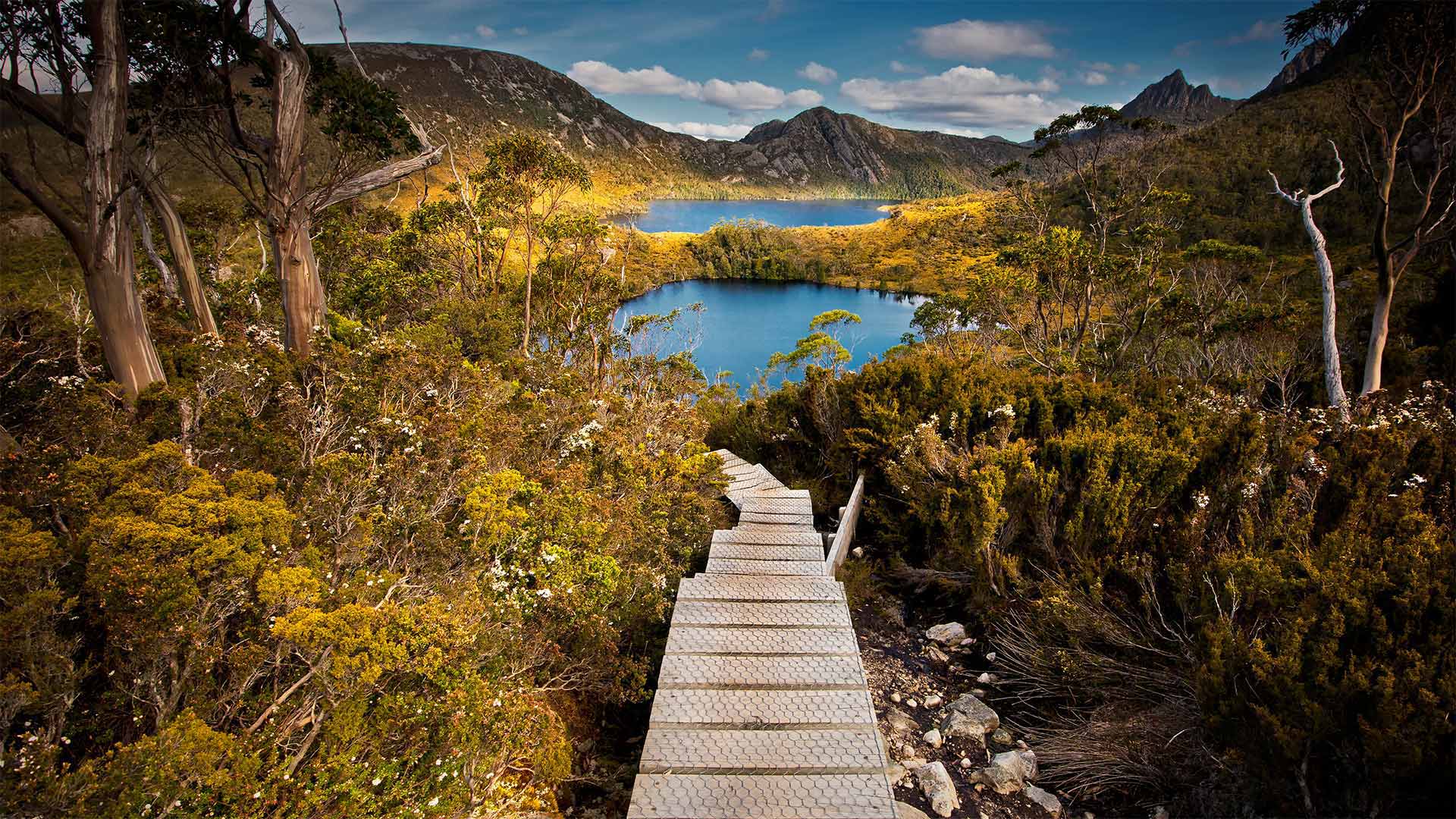
摇篮山-圣克莱尔湖国家公园,澳大利亚塔斯马尼亚州 Cradle Mountain-Lake St. Clair National Park, Tasmania, Australia (© Paparwin Tanupatarachai/Getty Images)
The wild heart of Tasmania
This boardwalk leads to one of the many lakes that dot Tasmania's Cradle Mountain–Lake St. Clair National Park, one of the crown jewels of the island's Wilderness World Heritage area. Covering over 623 square miles in the interior of the island, the park is home to an incredible diversity of flora and fauna. Marsupials like Bennett's wallabies, quolls, Tasmanian pademelon, and the legendary Tasmanian devils, as well as short-beaked echidnas, platypuses, wombats, and Tasmanian pygmy possums can be found in its ancient forests and lakes.
In late April and into May, locals and visitors delight in the 'Turning of the Fagus' when the leaves of the deciduous Tasmanian beech trees turn brilliantly yellow, orange, and red. The Overland Track, as 65-mile-long circuit of the park is a popular route for visitors, whether exploring a portion of it over a day or taking a week to complete the entire route. Overnight hikers can stay in warming huts built along the way and spend the night dazzled by the stars and the aurora australis (aka the southern lights) in one of island's best stargazing locations.
塔斯马尼亚的野心
这条木板路通往点缀塔斯马尼亚摇篮山的众多湖泊之一——圣克莱尔湖国家公园,是该岛荒野世界遗产区的王冠明珠之一。这个公园占地623平方英里,是岛上动植物多样性令人难以置信的家园。像贝内特的小袋鼠、小袋鼠、塔斯马尼亚的帕德梅隆和传说中的塔斯马尼亚魔鬼,以及短嘴针鼹、鸭嘴兽、袋熊和塔斯马尼亚侏儒负鼠等有袋动物都可以在其古老的森林和湖泊中找到。
在4月下旬到5月,当地人和游客都喜欢“水青冈的转变”,因为每年落叶的塔斯马尼亚山毛榉树的叶子都会变成明亮的黄色、橙色和红色。陆上赛道,作为公园65英里长的赛道,是游客的热门路线,无论是探索一天的一部分,还是花一周的时间完成整个路线。夜间徒步旅行者可以住在沿途建造的温暖小屋里,在岛上最好的观星地点之一度过被星星和南极光(又名南极光)所眩目的夜晚。
温尼伯湖沿岸的春日冰雪,曼尼托巴 Spring ice along the shore of Lake Winnipeg, Manitoba (© Mike Grandmaison/Jaynes Gallery/DanitaDelimont.com)
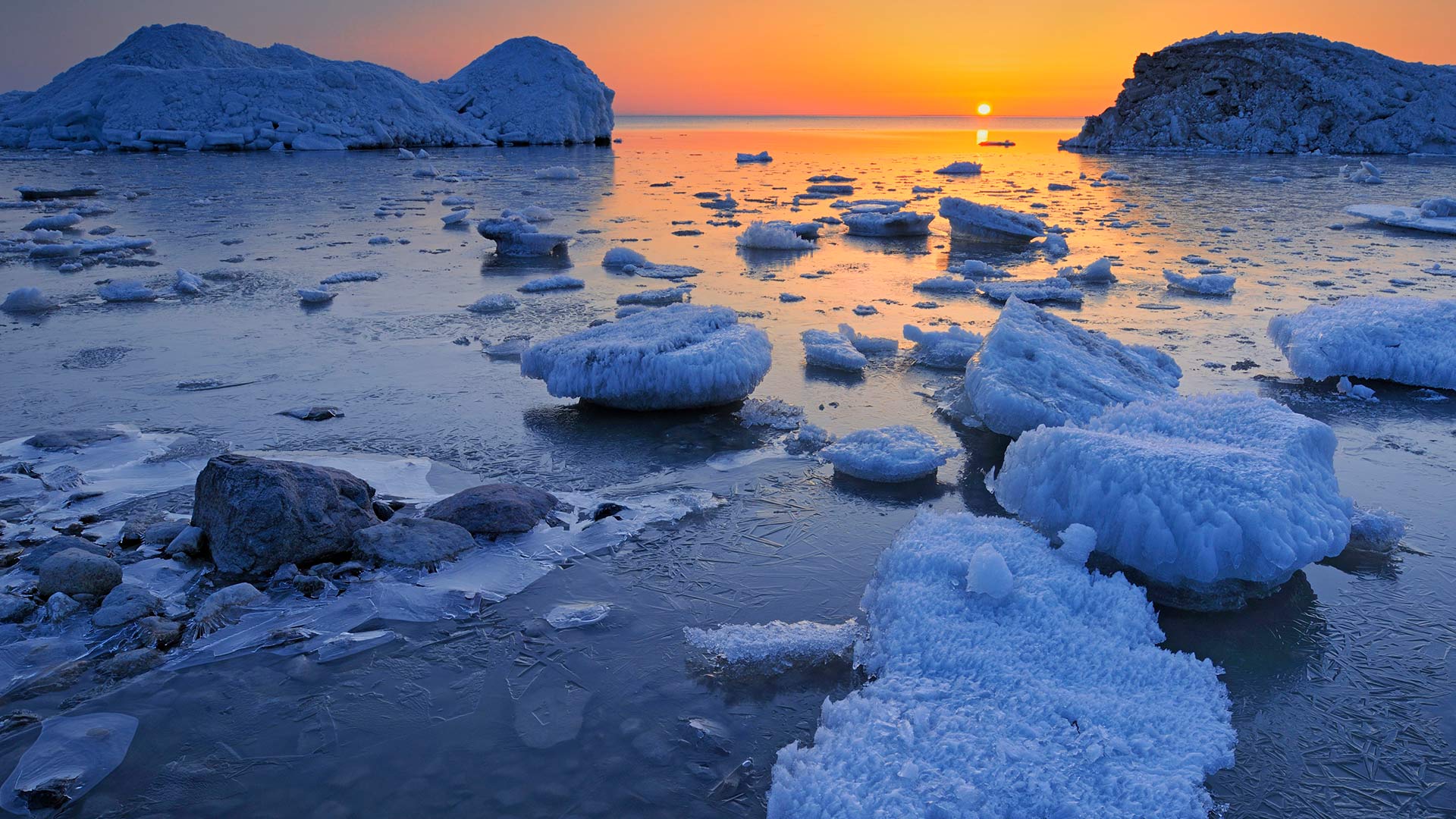
温尼伯湖沿岸的春日冰雪,曼尼托巴 Spring ice along the shore of Lake Winnipeg, Manitoba (© Mike Grandmaison/Jaynes Gallery/DanitaDelimont.com)
A hub for fishing
Located in central Manitoba, Lake Winnipeg is the sixth largest freshwater lake in Canada. It is 435 kilometres long and at least 109 kilometres wide. With an area of approximately 24,400 square kilometres, Lake Winnipeg boasts a shoreline consisting of pristine white sand beaches, limestone cliffs and boreal forests. Hence, this area sits as a huge nesting ground for birds like pelicans, gulls and cormorants. Additionally, abundant fish species can be found here as well. As a matter of fact, Lake Winnipeg is a commercial fishing hub and contributes significantly to Manitoba’s fishing industry revenue. So, whatever the season may be, professional anglers and general fans of fishing can be spotted here all year-round.
钓鱼的中心
温尼伯湖位于马尼托巴省中部,是加拿大第六大淡水湖。它长435公里,宽至少109公里。温尼伯湖面积约24400平方公里,拥有由原始的白色沙滩、石灰岩悬崖和北方森林组成的海岸线。因此,这个地区是鹈鹕、海鸥和鸬鹚等鸟类的巨大筑巢地。此外,这里还有丰富的鱼类。事实上,温尼伯湖是一个商业渔业中心,为马尼托巴省渔业收入做出了重大贡献。因此,无论季节如何,这里终年都可以看到专业钓鱼者和钓鱼爱好者。
座头鲸妈妈将她熟睡的幼鲸推到水面,夏威夷毛伊岛 Humpback whale mother pushes her sleeping calf to surface, Maui, Hawaii (© Ralph Pace/Minden Pictures)
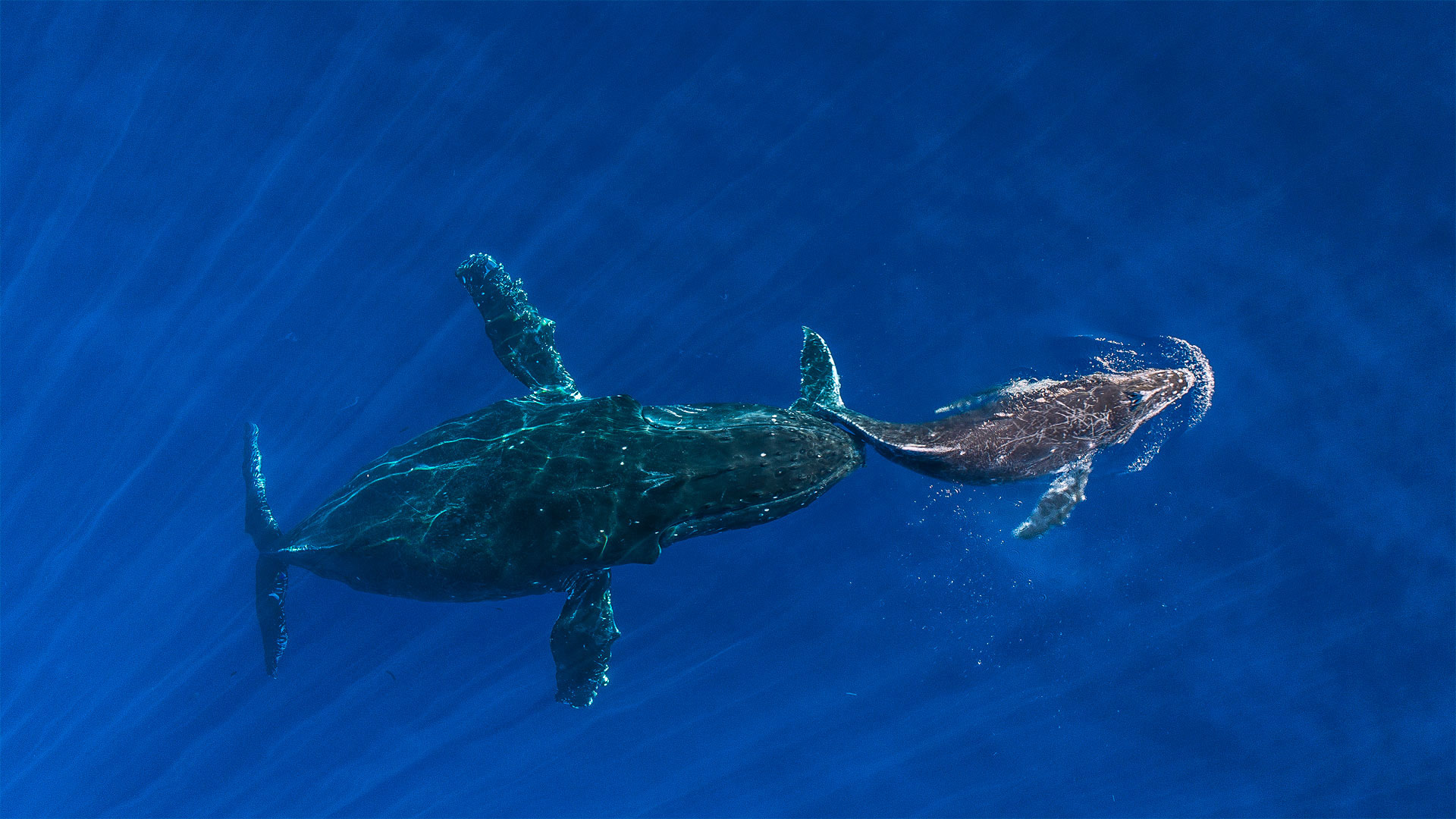
座头鲸妈妈将她熟睡的幼鲸推到水面,夏威夷毛伊岛 Humpback whale mother pushes her sleeping calf to surface, Maui, Hawaii (© Ralph Pace/Minden Pictures)
A whale of a picture
The family drama you see playing out here in the Pacific Ocean near Maui, Hawaii, is a humpback whale calf getting a little nudge from its mom. She presumably wants the sleepy youngster to practice surfacing, something these amazing marine mammals are famous for doing in dramatic fashion. Winter is calving season, when thousands of humpbacks swim to the warm waters off Hawaii, making them a common sight from November until April. Because they're known to hang around near the ocean's surface, breaching or slapping the water with their tails, humpbacks are a favorite of whale watchers everywhere.
Most humpbacks are nomadic and can be found in all the oceans of the world, with some populations migrating distances of up to 5,000 miles as they move from breeding grounds in warmer, tropical waters, to colder areas where food is more plentiful. And when they eat, they don't mess around, consuming up to 2,000 pounds of food each day. They eat tiny crustaceans called krill, as well as small fish. Once on the verge of extinction because of commercial whaling, legislative protections in the US and around the world have helped the humpback population to rebound to somewhere around 80,000 worldwide.
像鲸鱼一样的图片
你在夏威夷毛伊岛附近的太平洋上看到的家庭剧,是一头座头鲸幼崽被它妈妈轻轻推了一下。她大概是想让这个昏昏欲睡的年轻人练习浮出水面,这些神奇的海洋哺乳动物以戏剧化的方式出名。冬季是产犊季节,成千上万的座头鲸游到夏威夷附近温暖的水域,使它们从11月到4月成为常见的景象。因为众所周知,座头鲸在海面附近游荡,用尾巴冲破水面或拍打水面,所以座头鲸是各地鲸鱼观察者的最爱。
大多数座头鲸都是游牧民族,分布在世界上所有的海洋中,当它们从温暖的热带水域的繁殖地迁徙到食物更丰富的寒冷地区时,有些座头鲸的迁徙距离可达5000英里。当他们吃东西的时候,他们不会乱来,每天消耗多达2000磅的食物。它们吃被称为磷虾的微小甲壳类动物,以及小鱼。由于商业捕鲸一度濒临灭绝,美国和世界各地的立法保护帮助座头鲸数量反弹至全球约8万头。